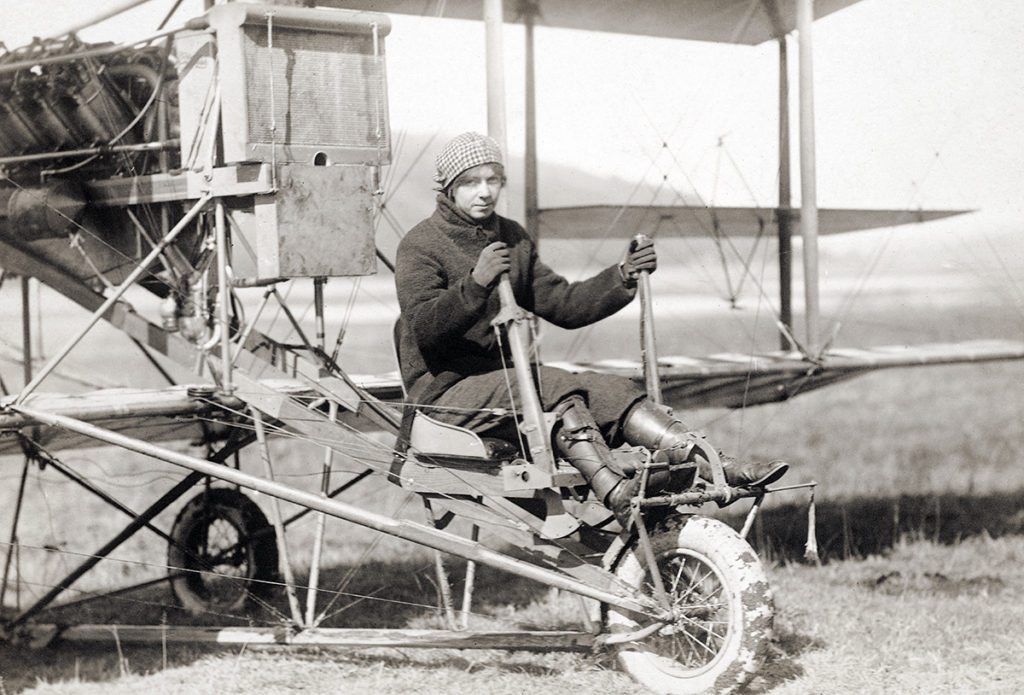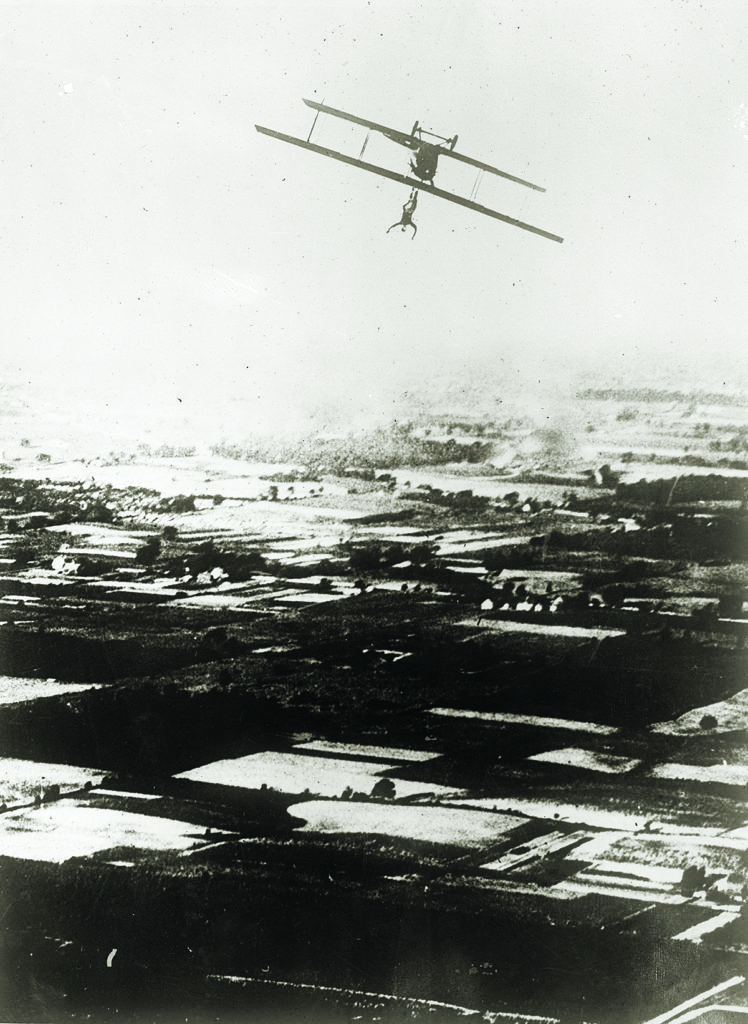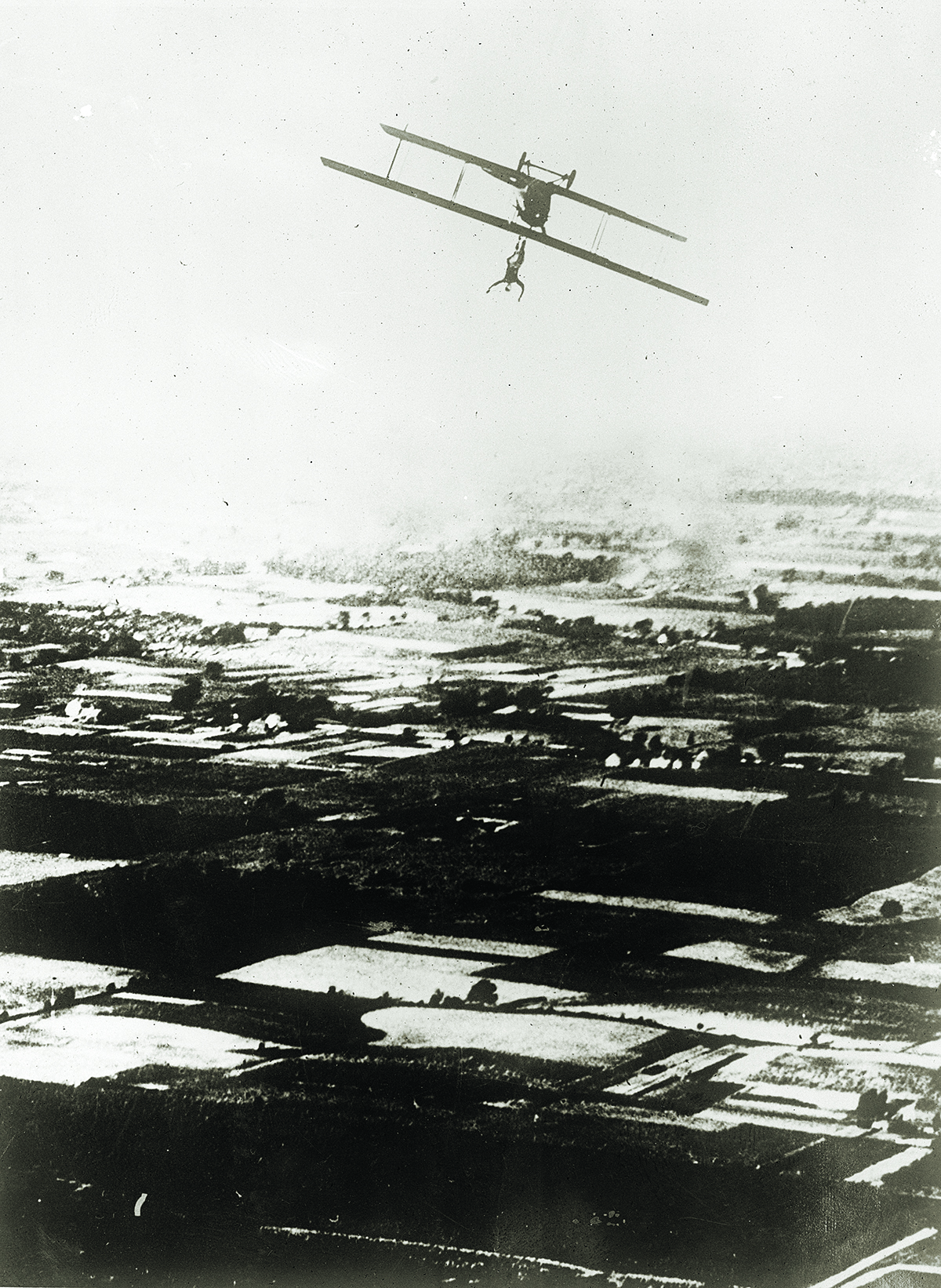Clad in a chauffeur’s fur-lined jodhpurs, leather breeches, a leather mask, several layers of clothing and a leather coat, 29-year-old Ruth Bancroft Law took off in a 100-horsepower Curtiss pusher biplane from Chicago’s Grant Park at 7:25 a.m. on Nov. 19, 1916. She was seeking to set a long-distance, nonstop flying record to New York.
Although Glenn Curtiss had refused to provide a new twin-engine airplane to the 5-foot-5 pilot (Law believed he did not think she could handle it), his mechanics had refitted her airplane with overhangs on the upper wing for additional lift and added extra fuel tanks. She sewed a piece of paper with her compass bearings to the cuff of her glove and had a box with her route map on rollers tied to her left knee. She flew at 5,000 feet.
When her fuel ran out, Law glided for the last two miles before touching down in Hornell, New York. The time was 2:07 p.m. and she had covered 590 miles, 138 more than the previous record holder, Victor Carlström.

GET HISTORY’S GREATEST TALES—RIGHT IN YOUR INBOX
Subscribe to our HistoryNet Now! newsletter for the best of the past, delivered every Monday and Thursday.
Aero Club of America President Alan R. Hawley lauded Law’s “125 pounds of nerve and pluck” and awarded her a check for $2,500. Corinne Robinson, sister of former president Theodore Roosevelt, dedicated a poem to her. New York City’s J. B. Greenhut & Company department store exhibited her airplane. Vaudeville offers arrived, including one for $35,000. Ohio’s Alliance Review and Leader wrote, “The record flight of Miss Ruth Law, aviatrix … is another proof of the ability of women to do things.”
BReaking records
America’s first female flying instructor, the first U.S. female pilot to loop-the-loop, the first woman to fly at night and the first pilot to fly airmail in the Philippines, Ruth Law was born in Lynn, Massachusetts, on March, 21, 1887, the third of four children. Her father, Frederick, a traveling salesman, had served in the Navy. Her parents’ marriage ended sometime before 1902, when her father remarried.
In August 1907, Law married fellow Lynn native Charles Augustus Oliver. Her brother Rodman had experienced some success with stunts such as parachuting off the Statue of Liberty, giving Oliver the idea of buying an airplane and holding exhibition flights with Rodman. Rodman wasn’t interested in learning to fly, so, as Law said, “I asked for the privilege of letting me fly.”
Oliver bought a Wright Model B from Orville Wright, although Wright would not train Law because, she said, “[h]e didn’t think women could fly.” She trained instead with Arch Freeman of Burgess Company & Curtis, Inc., in Marblehead, Massachusetts.
“I liked it from the very first,” she said. “I was never afraid of it.”
She began to give exhibition flights in August 1912 and in November she became the sixth woman in the United States to earn a pilot’s license when the Aero Club of America issued her license No. 188. Beginning in January 1913, she took people aloft, charging between $14 and $25 depending on duration, and served as a flight instructor in Daytona Beach, Florida. While at Daytona, she entered Brooklyn Dodgers lore when she tossed a grapefruit from her airplane at manager Wilbert Robinson in a publicity stunt during spring training. After adding stunt flying to her repertoire she became a popular attraction at state fairs and similar venues. Her flight to 11,200 feet in May 1916 and another to 14,700 feet the next September set new records for female pilots.

She and her husband submitted passport applications in January 1917 for a trip to England and France to observe military aviation. Law’s application is a milestone, as it states, “Ruth Oliver, professionally known as Ruth Law.” Not until May 1925 did the married Esther Sayles Root win a lawsuit that enabled her to obtain a passport in her maiden name, so Law’s assertion of her professional identity is significant.
Government agent
After Law returned from Europe, the government sent her on a cross-country air trip to promote Liberty bonds and recruit for the Aviation Section of the Signal Corps, even granting her special permission to wear a uniform during her recruitment efforts. In an article titled “Enlist!” in the October 1917 issue of Air Travel, Law urged men to join the Aviation Section because, she said, “I can’t go because I ain’t a man.”
Nonetheless, she intended to try. In November, Law applied to the Aviation Section, aiming for a commission as first lieutenant. The judge advocate general ruled that the Army could not accept women. Undaunted, Law allied with New York Congressman George Murray Hulbert to introduce a bill to allow women to join the Aviation Section. The bill failed to pass.
Law then published “Let Women Fly!” in the February 1918 Air Travel, writing, “I felt that it was a question of training and experience, rather than of sex, and that the world was at its old game of developing, speeding up and training its man power, while disregarding, passing over and wasting its woman power.” She added prophetically, “I feel sure that the time will come when women will be welcomed in the air service.”
Global Daredevil
In early 1919, Law gave exhibition flights in Japan before a Tokyo audience reported at 50,000. She visited the Philippines on the same trip, where she made her pioneering airmail flight. In 1920 she founded Ruth Law’s Flying Circus, featuring several airplanes and daredevil stunts — such as Law standing on a wing while the pilot looped-the-loop — races between cars and airplanes and car-to-airplane transfers.
Tragedy struck on October 1921, when Madeline Davis, who was auditioning for a place in the flying circus, died during an attempted car-plane transfer (Law was driving the car). The incident may have led her husband to announce Law’s retirement from flying (without her knowledge) in February 1922. Law, who admitted to “many near misses,” reported that Oliver feared the stunts were becoming increasingly dangerous and had even suffered a nervous breakdown, perhaps from worry.
The couple retired to California. Although Law expressed interest in 1924 in flying helicopters and took the controls of a friend’s airplane in 1947, these episodes did not lead to a permanent return to the air for a pioneer whose flying was more than an occupation or pastime. As Law, who died in 1970, wrote, “the airplane was a part of me.”
This article appeared in the Autumn 2022 issue of Aviation History. Click here to subscribe.
historynet magazines
Our 9 best-selling history titles feature in-depth storytelling and iconic imagery to engage and inform on the people, the wars, and the events that shaped America and the world.







